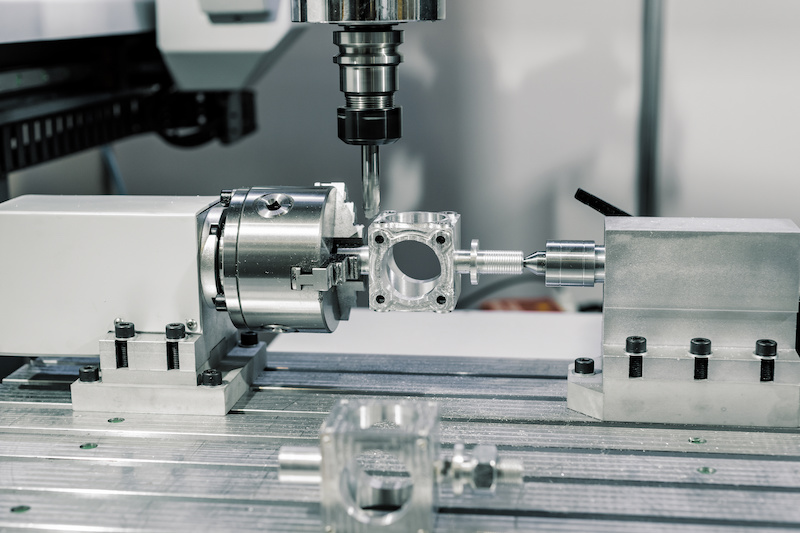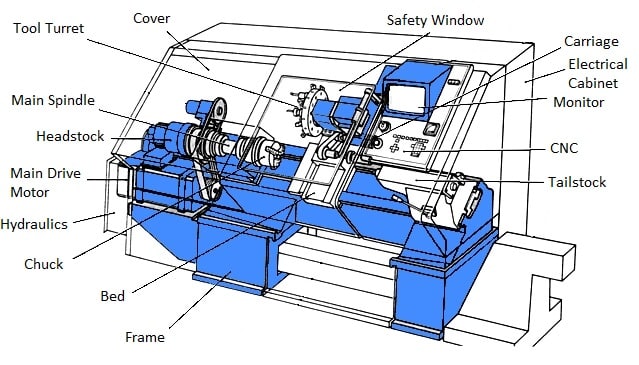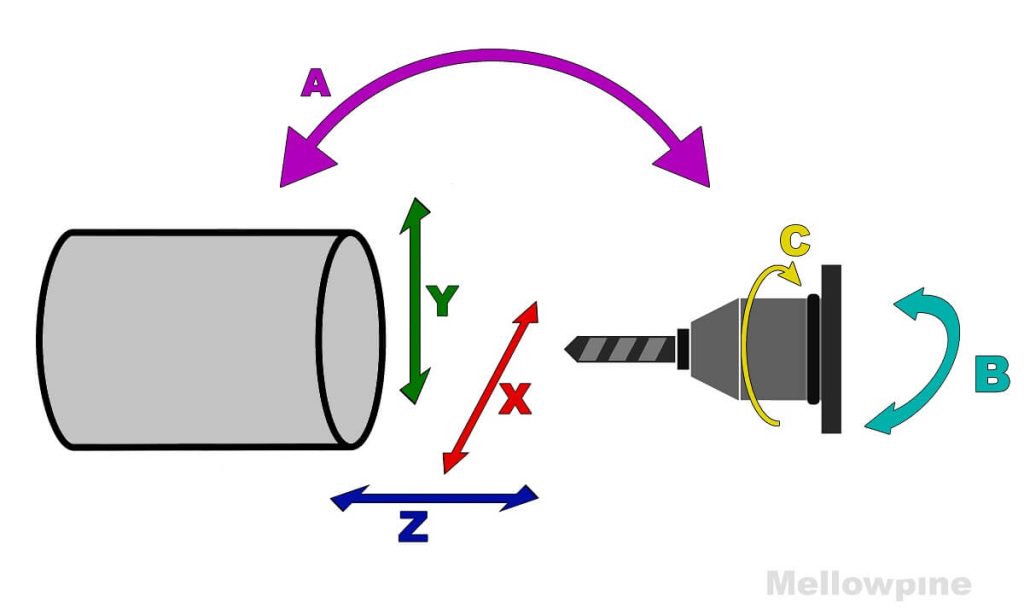Table of Contents
Do you ever wonder how the intricate and precise designs on metal parts are created? The answer lies in the programming of a CNC (Computer Numerical Control) lathe. Specifically, the process of programming a taper on a CNC lathe is a vital skill in the manufacturing industry.
A taper refers to a gradual decrease in diameter of a cylindrical object. Programming this on a CNC lathe involves specifying the dimensions and angles to be cut, which requires a thorough understanding of the machine’s capabilities and the desired outcome. In this article, we will delve into the step-by-step process of programming a taper on a CNC lathe, from selecting the appropriate tooling to testing the final product.
- First, select the appropriate tool and insert it into the tool holder.
- Enter the required dimensions for the taper into the CNC program.
- Set the appropriate spindle speed and feed rate for the material being machined.
- Choose the direction of the taper and the angle of the taper.
- Run a test program to ensure the taper is programmed correctly.
How to Program a Taper on a CNC Lathe?
Programming a taper on a CNC lathe can be a challenging task, especially for those who are new to the world of CNC machining. However, with the right knowledge and tools, anyone can program a taper on a CNC lathe. In this article, we will provide you with a step-by-step guide on how to program a taper on a CNC lathe.
Step 1: Understand the Taper
Before you start programming a taper on a CNC lathe, it is important to understand what a taper is. A taper is a conical shape that is created on the surface of a workpiece. It is typically used to create a precise fit between two parts or to facilitate the removal of a workpiece from a mold.
To program a taper on a CNC lathe, you need to know the angle of the taper, the length of the taper, and the location of the taper on the workpiece. Once you have this information, you can start programming the taper.
Benefits of Taper Programming
– Provides precise fit between two parts
– Facilitates removal of workpiece from mold
– Improves overall accuracy of machining process
Step 2: Select the Tool
The next step in programming a taper on a CNC lathe is to select the right tool. The tool you choose will depend on the angle and length of the taper, as well as the material you are working with. You may need to use a different tool for each taper you program.
Once you have selected the tool, you need to enter the tool information into the CNC lathe. This includes the tool number, the tool diameter, and the tool length. This information will be used by the CNC lathe to determine the correct tool path for the taper.
VS of Taper Programming
– Saves time and reduces errors compared to manual taper programming
– Provides greater precision and accuracy
– Allows for more complex taper shapes
Step 3: Set the Parameters
The next step is to set the parameters for the taper. This includes the angle of the taper, the length of the taper, and the location of the taper on the workpiece. You will also need to set the spindle speed and the feed rate for the tool.
Once you have set the parameters, you need to enter them into the CNC lathe. This will tell the CNC lathe how to move the tool to create the taper.
Tables for Taper Programming
| Taper Angle (degrees) | Length of Taper (inches) | Location on Workpiece |
|---|---|---|
| 5 | 2 | Center |
| 10 | 3 | Left |
| 15 | 4 | Right |
Step 4: Create the Tool Path
The final step is to create the tool path for the taper. This is done using CAM software, which generates the G-code that the CNC lathe will use to move the tool. The CAM software takes into account the parameters you have set, as well as the tool information, to create the tool path.
Once the tool path has been created, you need to transfer it to the CNC lathe. This is done using a USB drive or Ethernet connection. Once the tool path has been transferred, you can start the machining process.
Benefits of Taper Programming
– Provides greater flexibility and control over the machining process
– Reduces the risk of errors and rework
– Increases efficiency and productivity
In conclusion, programming a taper on a CNC lathe requires a good understanding of the taper, the selection of the right tool, the setting of the parameters, and the creation of the tool path. By following these steps, you can create precise and accurate tapers that meet your machining requirements.
Frequently Asked Questions
Programming a taper on a CNC lathe can be a complex task, especially for beginners. Here are some frequently asked questions about how to program a taper on a CNC lathe.
What is a taper on a CNC lathe?
A taper on a CNC lathe refers to the gradual change in diameter of a cylindrical workpiece. This is achieved by moving the cutting tool at an angle to the workpiece as it rotates. Tapers are commonly used in the manufacturing of parts such as cones, cylinders, and other parts with a non-uniform diameter.
To program a taper on a CNC lathe, the operator must specify the angle of the taper, the length of the taper, and the rate of change in diameter. The programming language used for this task is typically G-code, which specifies the tool path and other machining parameters.
How do you calculate the angle of a taper?
The angle of a taper is calculated by dividing the difference in diameter between the two ends of the taper by the length of the taper. For example, if a workpiece has a diameter of 2 inches at one end and 1 inch at the other end, and the length of the taper is 4 inches, the angle of the taper would be (2-1)/4 = 0.25 inches per inch or 14.04 degrees.
Once the angle of the taper has been calculated, it can be programmed into the CNC lathe using G-code. The operator must specify the starting and ending diameters, the length of the taper, and the angle of the taper. The CNC lathe will then automatically move the cutting tool at the correct angle to create the taper.
What is the difference between a roughing pass and a finishing pass?
A roughing pass is the first pass of the cutting tool over the workpiece, which removes the majority of the material. This pass is typically done at a higher feed rate and a shallower depth of cut to remove material quickly. A finishing pass is the final pass of the cutting tool over the workpiece, which removes any remaining material and creates a smooth surface finish. This pass is typically done at a slower feed rate and a deeper depth of cut to create a high-quality finish.
When programming a taper on a CNC lathe, the operator must specify the number of roughing passes and finishing passes required to achieve the desired taper. The roughing passes will remove the majority of the material, while the finishing passes will create the smooth surface finish.
What is the difference between climb milling and conventional milling?
Climb milling and conventional milling are two different cutting methods used in CNC machining. In climb milling, the cutting tool moves in the same direction as the workpiece rotation, while in conventional milling, the cutting tool moves in the opposite direction to the workpiece rotation.
When programming a taper on a CNC lathe, the operator must specify the cutting method to be used. Climb milling is generally preferred for tapers, as it produces a smoother surface finish and reduces the likelihood of the cutting tool digging into the workpiece. However, conventional milling may be used in certain situations, such as when the workpiece is thin or delicate.
What is the role of coolant in CNC machining?
Coolant is a liquid or gas that is used to cool and lubricate the cutting tool during CNC machining. This helps to prevent the cutting tool from overheating and breaking, and also helps to reduce the amount of friction between the cutting tool and the workpiece.
When programming a taper on a CNC lathe, the operator must specify the type and amount of coolant to be used. Different types of coolant may be used depending on the material being machined and the cutting tool being used. The amount of coolant used will also depend on the complexity of the taper and the speed of the cutting tool.
In conclusion, programming a taper on a CNC lathe may seem daunting at first, but with the right knowledge and tools, it can be accomplished with ease. By understanding the basics of G-code and M-code, as well as utilizing the correct tooling and programming techniques, you can achieve precise and accurate tapers on your workpiece.
It’s important to remember that practice and experimentation are key to mastering the art of taper programming. Don’t be afraid to try new techniques and adjust your program as needed to achieve the desired results. With each successful taper, you’ll gain confidence and improve your skills as a CNC programmer.
Overall, programming a taper on a CNC lathe is an essential skill for any machinist or engineer. By following the steps outlined in this guide and continuing to learn and grow in your programming abilities, you can produce high-quality parts and achieve success in your manufacturing endeavors.
Request a quote today!
[contact-form-7 id="1578" title="Contact form"]
Please compress the file into a ZIP or RAR file before uploading. Alternatively, send through your RFQ by email.
enquires@unitymanufacture.com





